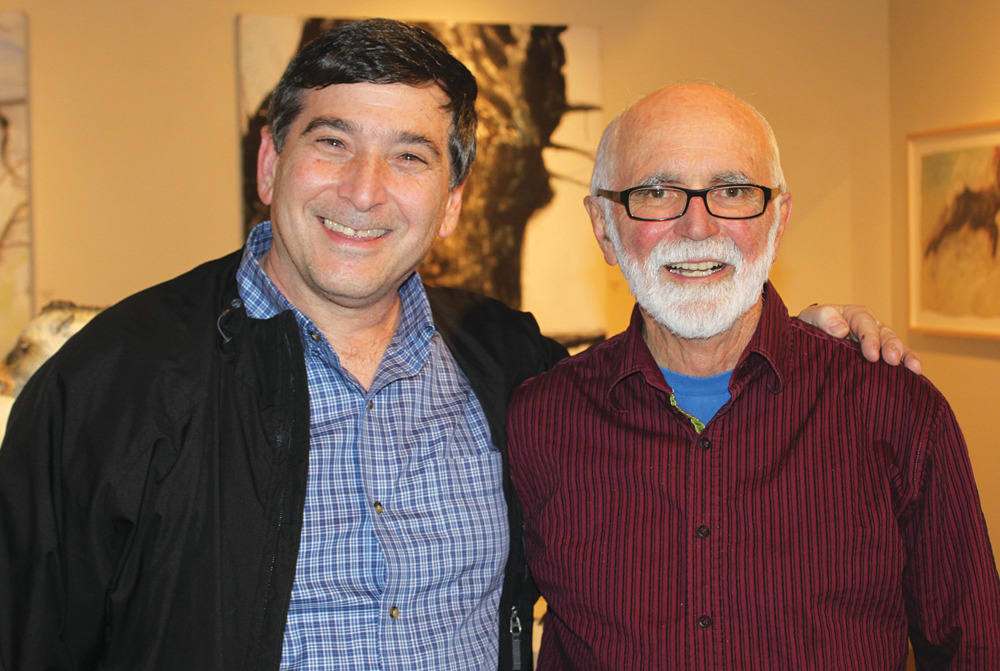I was first introduced to the ceramics of Joe Fafard while attending the Ontario College of Art in the early 1970s. He was part of a group of sculptors working with clay in western Canada that had captured the attention of the media.

Joe Fafard and Irv Osterer at the Cube Gallery in Ottawa.
Even though renowned New York art critic Clement Greenberg dismissed his work as being “…a little bit too ‘mignon,’” Fafard was determined to follow his own artistic path. Instead of submitting to modern abstract painting and minimalist sculpture trends, Fafard decided that his ceramic subjects should emanate from his own experience, and would include the people and farm animals that populated his hometown.
His work was featured in Arts Canada, and his seated portraits, infused with a variety of fun props, expanded to authors, artists, prime ministers and priests. “I Don’t Have to Work that Big” (www.youtube.com/watch?v=4ToRyoYO8g) by the National Film Board documented the evolution of this process and showed a number of prominent Canadians admiring their portraits.
What is wonderful about Fafard’s oeuvre is that it is accessible to a wide audience. I don’t know of anyone who has not been impressed by his work. Fafard’s famous cows, now life-size and cast in bronze, can be seen grazing in front of the Toronto Dominion Centre, adding a bit of pastoral charm to the urban landscape. Some of his current works, a series of intricately die cut, carefully enameled, steel wild horses, give the impression of a herd of these majestic animals in motion. He was awarded the Order of Canada in 1981 for his monumental contribution to the arts in this country.
Whenever I begin a ceramics unit, I always make sure that the class has a chance to get acquainted with Joe’s work. Several impressive exhibition catalogues are presented and I even bring in the small bronze piece that I own, to make sure the students have an understanding of how the artist has created seemingly lifelike sculpture by distorting our notions of reality.
It is one thing to discuss the elements and principles of design in a classroom—but nothing eclipses the experience of seeing the work and interacting with it. Queen Elizabeth is in the National Gallery’s permanent collection and has always been popular with my students. One can see first hand the non-traditional colouring techniques the artist has used, and the slightly disproportionately larger hands and feet. The fact that the monarch’s purse is resting carefully behind her infuses the work with a note of humour—a quality that is evident in much of Fafard’s work. A large equestrian installation is now part of the Gallery’s outdoor sculpture garden.
I received a late autumn notice announcing “Prairie Companions” a joint show involving Fafard and lifelong friend Russel Yuristy at the Cube Gallery in Ottawa’s trendy Westboro Village. I called colleague Evelyn Michaud and together we viewed the breathtaking work at the opening reception. That so many of Fafard’s pieces were being shown together in a local independent gallery was simply beyond belief.
The show did not disappoint.
Yuristy is a fine painter and printmaker whose art also focuses on personal experience with nature and local wildlife and was the perfect partner for this endeavour. His impressive pieces filled the walls of the gallery. Fafard had the floor. His horses and cows are infused with vitality and have to be seen to be believed. Three large wolf bronzes acted as guardians of the exhibit, and their eyes seemed to follow you through the gallery space.
I congratulated gallery owner Don Monet for making this opportunity possible, and judging by the number of red “sold” stickers, the people in Ottawa were eager to see more of Joe and Russel’s work.

Theresa Reilly and Queen Elizabeth.
When I discovered that Fafard would be at the gallery later in the week, I was determined to make a second visit and encouraged the fine arts teachers in my department to come along.
Meeting one’s heroes can be daunting and even somewhat disappointing when the experience does not live up to personal expectations. Nothing could have been farther from the truth with Joe. I had a chance to tell the artist something I had always wanted to tell him—that beyond my personal admiration for all he has created, his work has had a profound influence on all my students, and he has really made a difference in their lives.
We talked for about fifteen minutes. I confessed that I loved an early seated figure he had created of Henri Richard and asked who owned the piece today. He smiled warmly as kindred hockey fans often do, and said it was in his own personal collection and that he had always admired the “Pocket Rocket’s” tenacity and skill on the ice in spite of his small stature.
Joe was kind enough to pose for a few pictures and took the trouble to sign my first day covers of the Canada Post stamps depicting his work. He confided that his father was a postmaster, and that the special commemorative postmark on the envelopes bore the name of his Sainte-Marthe, Saskatchewan post office.
It was an afternoon I will always remember.
ABOUT THE AUTHOR
Irv Osterer
Irv Osterer is the Department Head of Fine Arts and Technology at Merivale High School in Ottawa, ON.
This article is from Canadian Teacher Magazine/s Jan/Feb 2013 issue.













